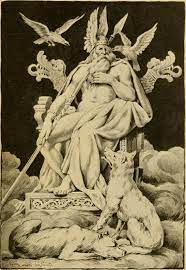

ORIGIN: Germanic
TYPE: Chief sky god, god of war.
KNOWN PERIOD OF WORSHIP: Circa 500 BCE and probably earlier until Christianization circa1 1100 CE.
SYNONYMS: Tyr; Tiw or Tig (Anglo-Saxon); Teiwa (archaic).
CENTER(S) OF CULT: scattered forest sanctuaries.
ART REFERENCES: reliefs in stone and metal.
LITERARY SOURCES: Runic inscriptions (see Wodan).
INFORMATION: Germanic war god and probably chief among their sky gods, one of two contenders on which OThin may have been modeled in Nordic (Icelandic) culture. Classical writers identified the Roman war god Mars with Tiwaz, thus for the third day of the week we have mardi in French but Tuesday in English. The runic symbol for Tiwaz is sometimes cut on spears, presumably to offer talismanic protection. Tiwaz represents law and order and appears a a more honest judiciary than Othin. (see Othin).
According to legend Tiwa is a one-armed god, having sacrificed his hand to the jaws of the wolf Fenris so that it might be bound up. This may have been the origin of a practice by which, according to Tacitus, the Germanic Semnones tribe bound the hands and feet of those entering a woodland sanctuary, probably decicated to Tiwaz. At Ragnarok (doom) it is believed that Fenrir will break free and swallow the sun. According to Snorri (Prose Edda) the wolf Garm, possibly Fenrir by another name, kills Tiwaz in the final battle of the gods. Place names such as Tuesley in Surrey, England, derive fro the name of the God.